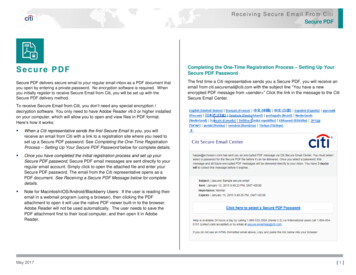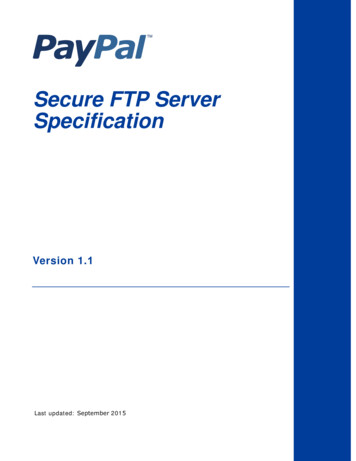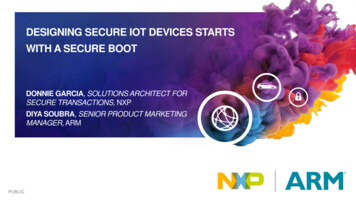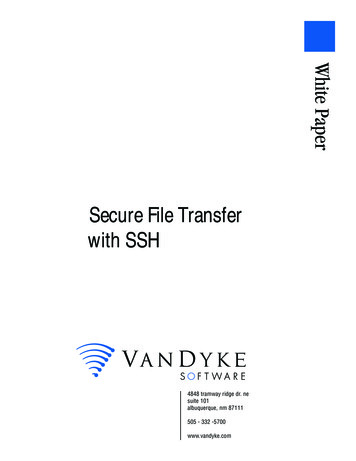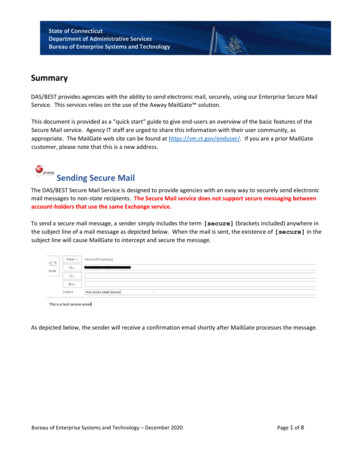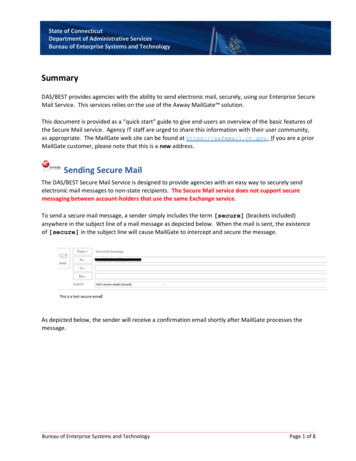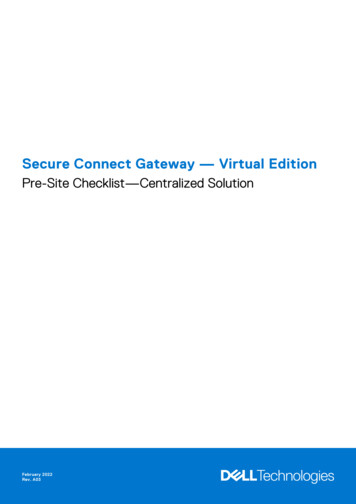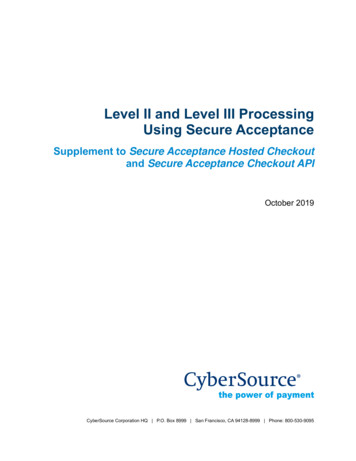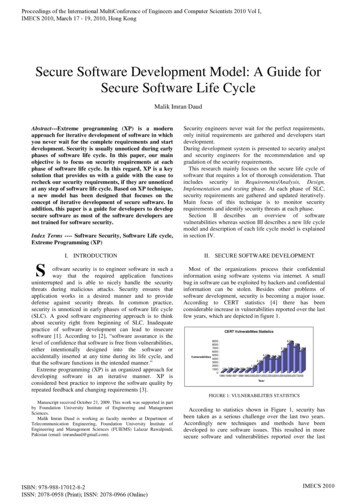
Transcription
Proceedings of the International MultiConference of Engineers and Computer Scientists 2010 Vol I,IMECS 2010, March 17 - 19, 2010, Hong KongSecure Software Development Model: A Guide forSecure Software Life CycleMalik Imran DaudAbstract---Extreme programming (XP) is a modernapproach for iterative development of software in whichyou never wait for the complete requirements and startdevelopment. Security is usually unnoticed during earlyphases of software life cycle. In this paper, our mainobjective is to focus on security requirements at eachphase of software life cycle. In this regard, XP is a keysolution that provides us with a guide with the ease torecheck our security requirements, if they are unnoticedat any step of software life cycle. Based on XP technique,a new model has been designed that focuses on theconcept of iterative development of secure software. Inaddition, this paper is a guide for developers to developsecure software as most of the software developers arenot trained for software security.Index Terms ---- Software Security, Software Life cycle,Extreme Programming (XP)I. INTRODUCTIONSoftware security is to engineer software in such away that the required application functionsuninterrupted and is able to nicely handle the securitythreats during malicious attacks. Security ensures thatapplication works in a desired manner and to providedefense against security threats. In common practice,security is unnoticed in early phases of software life cycle(SLC). A good software engineering approach is to thinkabout security right from beginning of SLC. Inadequatepractice of software development can lead to insecuresoftware [1]. According to [2], “software assurance is thelevel of confidence that software is free from vulnerabilities,either intentionally designed into the software oraccidentally inserted at any time during its life cycle, andthat the software functions in the intended manner.”Extreme programming (XP) is an organized approach fordeveloping software in an iterative manner. XP isconsidered best practice to improve the software quality byrepeated feedback and changing requirements [3].Security engineers never wait for the perfect requirements,only initial requirements are gathered and developers startdevelopment.During development system is presented to security analystand security engineers for the recommendation and upgradation of the security requirements.This research mainly focuses on the secure life cycle ofsoftware that requires a lot of thorough consideration. Thatincludes security in Requirements/Analysis, Design,Implementation and testing phase. At each phase of SLC,security requirements are gathered and updated iteratively.Main focus of this technique is to monitor securityrequirements and identify security threats at each phase.Section II describes an overview of softwarevulnerabilities whereas section III describes a new life cyclemodel and description of each life cycle model is explainedin section IV.II. SECURE SOFTWARE DEVELOPMENTMost of the organizations process their confidentialinformation using software systems via internet. A smallbug in software can be exploited by hackers and confidentialinformation can be stolen. Besides other problems ofsoftware development, security is becoming a major issue.According to CERT statistics [4] there has beenconsiderable increase in vulnerabilities reported over the lastfew years, which are depicted in figure 1.CERT Vulnerabilities 37171 345 311 262 05200620072008YearFIGURE 1: VULNERABILITIES STATISTICSManuscript received October 21, 2009. This work was supported in partby Foundation University Institute of Engineering and ManagementSciences.Malik Imran Daud is working as faculty member at Department ofTelecommunication Engineering, Foundation University Institute ofEngineering and Management Sciences (FUIEMS) Lalazar Rawalpindi,Pakistan (email: imrandaud@gmail.com).ISBN: 978-988-17012-8-2ISSN: 2078-0958 (Print); ISSN: 2078-0966 (Online)According to statistics shown in Figure 1, security hasbeen taken as a serious challenge over the last two years.Accordingly new techniques and methods have beendeveloped to cure software issues. This resulted in moresecure software and vulnerabilities reported over the lastIMECS 2010
Proceedings of the International MultiConference of Engineers and Computer Scientists 2010 Vol I,IMECS 2010, March 17 - 19, 2010, Hong Kongtwo years are comparatively less. Considering thesestatistics there is a need to develop such approach forsoftware development that could guaranty security at eachphase of software life cycle. [5] lists common softwarevulnerabilities, these vulnerabilities are mainly design andcoding vulnerabilities which are unnoticed by the softwareengineers. For any secure software there are three main coreproperties which are Confidentiality, Integrity andavailability that is our guideline for designing newapproach.Requirements engineering is the main building block forany software development. Security engineers try to elicitsecurity requirements by different methods, e.g. user stories,abuse cases, etc. Figure 4 lists all the main operation to beperformed during SSLC. Based on the information providedby figure 4 we can derive following main sources to derivesecurity requirements these are: III. ITERATIVE METHOD OF SOFTWARE LIFECYCLESecurity itself is a complete life cycle of softwaredevelopment. Where as iterative method is considered moreefficient and reliable approach for software development.You have few set of requirements and start development anditeratively new requirements are fulfilled. Blend of securityand XP gives a new approach that is shown in figure 3.Figure 3 shows an iterative model of secure software lifecycle (SSLC) based on extreme programming concept.Functional Security RequirementsNon functional Security RequirementsDerived Security RequirementsUser storiesAbuse casesDuring analysis phase we get security requirements fromabove listed sources. Most of the occasion requirementsgathered from user stories and other sources are not welldefined. These requirements can be refined by securityfunctional requirements (SFR) module (Details are given insection ‘IV-A’).Test mentationRisksUncertainRequirementsUser StoriesRefinedRequirementsRequirementsKnown esTestingMitigation PlanSec ThreatsDesignDesign BugsNew SecurityRequirementsFIGURE 3: ITERATIVE LIFE CYCLE FOR SECURE SOFTWAREOnce the uncertain requirements are refined by SFRmodule, then we are ready to start designing our software.Design phase is important and requires more considerationin terms of security. Based on the information provided byanalysis phase (Security Requirements by user stories andSFR) a threat model is developed. If security engineer feelssome of the information is missing or some other securitythreats are possible then it goes back to analysis for therefinement of the security requirements. If security expertfinds no problems, then a mitigation plan is designed tocater all those threats listed in threat model. Securityvulnerabilities are identified during design phase and Table2 gives a guideline to find such vulnerabilities. All thevulnerabilities that a software system may suffer from aredocumented and passed to development team. DevelopersISBN: 978-988-17012-8-2ISSN: 2078-0958 (Print); ISSN: 2078-0966 (Online)start development by considering all vulnerabilities and theirmitigation plan designed during design phase.Once software is developed then it is handed over totesting team along with the documentation. During thisphase different testing methodologies are used as discussedin section ‘IV-C’. In this phase engineers try to find designor development bugs in software application. After thatsoftware application is ready for the deployment.IV. SECURE SOFTWARE LIFE CYCLE – AMODELSoftware is vulnerable to attack, when some securitylapses are overlooked during software life cycle. Softwaresecurity unnoticed during early phases of life cycle isinherited to later phases; therefore one phase transfers itsIMECS 2010
Proceedings of the International MultiConference of Engineers and Computer Scientists 2010 Vol I,IMECS 2010, March 17 - 19, 2010, Hong Kongvulnerabilities to the other phase. According to [6] softwareis vulnerable to threats that may occur during developmentof software. Security engineers may disrupt the softwareduring software development life cycle either by intentionalor unintentional modification of the requirement’sspecification, design document, source code or test cases.One should have a list of all major actions to be performedduring life cycle of software. Therefore, to ensure softwaresecurity following model has been designed that list all theactions to be performed during the life cycle of software. User StoriesSecurity FunctionalRequirementsUser RequirementsNon Functional SecurityRequirementsRequirements Misuse CasesMitigation PlanAnalysis ecurityUpgrade DeploymentUnit TestingFunctionalTestingPenetrationTestingFuzz TestingSecureSoftwareLifeCycleDesign Threat ModelInput Data TypesSecurity Use CasesSecurityTestinfunctional requirements list all the properties a system willpossess like its environment where it will run like UNIX,Windows, etc. Derived requirements are those requirementswhich are derived from functional and other securityrequirements.As far as software security requirements are concernedit comes in two different ways. One directly from userstories that can be user requirements and other securityrequirements are derived by the security engineers. Userstories are an effective way to derive user requirements inefficient way from rapid changing real world requirements.Security engineers derive rest of the user requirements andthese requirements are the security functional requirements.Common Criteria functional requirements [8] are the bestsource to derive such functional requirements. This ishelpful for the consumer and developer both to identifysecurity objective and security requirements.It is important to anticipate abnormal behavior for secureand reliable software application. Therefore, securityexperts need to create use cases to mitigate those abnormalbehaviors, i.e. misuse case. These are the cases, in which allthose actions or processes of system that can be exploited bya misuser. Figure 5 show a relationship between use caseand misuse case.Implementat Security ModulesKnown SecurityvulnerabilitiesFIGURE 4: SECURE LIFE CYCLE OF SOFTWAREFigure 4 depicts all the actions to be taken during the lifecycle of software to guarantee security in software. This lifecycle is iterative in nature; if some security modules are leftat any phase of life cycle, then we can go back to that phaseand fulfill those shortcomings. For example, if we aredesigning a cryptographic software that encipher anddecipher the text. Suppose we are in design phase and leftwith few cryptographic requirements during requirementphase. We can go back to requirement phase and updatethose cryptographic requirements and can continue ourdesign from same point from where we left. Each phase isdiscussed in following sections.A. SECURITY ANALYSIS / REQUIREMENTSFor any major project, requirements engineering hasalways been critical for its success. Security requirementsmay fall into three main categories [7] these are: i)Functional (Behavioral) security Requirements. ii) NonFunctional security Requirements. iii) Derived securityRequirements. Functional requirements list all the functionsthat a system will perform. These requirements relate toinput and output of a system and the relationship betweensinput and output. These requirements also specify theactions to be performed for a specific input. Whereas nonISBN: 978-988-17012-8-2ISSN: 2078-0958 (Print); ISSN: 2078-0966 (Online)FIGURE 5: USE CASE AND MISUSE CASES [9]SECURITY FUNCTIONAL REQUIREMENTSBefore defining security requirements, security engineersneed to identify those parts of the software system thatrequires security. These parts of the software system arecalled Target of Evaluation (TOE). Once TOE is identifiedthen finding security functional requirements (SFR) forthose parts becomes simple. [8] lists different set of classesdepending on the nature of application. Different set ofSFRs can be chosen for the required TOE. Once requiredSFRs are chosen, then table can be designed to monitor itsimplementation in required software application. SFRs arechosen to counter threats in TOE of software system. Forexample; if we are trying to gather SFR of a webapplication; Table 1 lists related SFR’s and their activity.There can be different TOE in a single software application;therefore different set of SFRs are collected for each TOE.IMECS 2010
Proceedings of the International MultiConference of Engineers and Computer Scientists 2010 Vol I,IMECS 2010, March 17 - 19, 2010, Hong KongTABLE 1: SFR ACTIVITY MODELClassFCO :CommunicationFCS :CryptographicSupportSFRDescriptionFCO NRRNon Repudiation ofOriginNon Repudiation ofReceiptFCS CKMCryptographic KeymanagementFCO NROFCS COPCryptographicOperationB. SECURITY DESIGN & IMPLEMENTATIONDesign phase shapes all the requirements into reality. Thisis a phase where, what and why of requirements becomewho, when, where, and how of the software to be [9].Design phase plays very important role where you givedesign to security requirements. As listed in figure 4, it issignificant to design a threat model for secure softwareapplication. Threat modeling is a technique to identifythreats, vulnerabilities and their countermeasures. Once wehave the security requirements and we have the data flowdiagrams (DFDs), now there is need to identify the entrypoints and exit points to the system from DFDs. These arethe points from where attacker can enter into the system.Once we have identified entry and exit points now identifyall possible threats that an attacker can exploit from thesepoints. Table 2 can be good source to find threats forparticular application. Let’s take an example of confidentialdata that needs to be stored. Security Engineer needs toidentify all possible attacks by asking questions like: whereto store this data, how to transfer data remotely, howattacker will manipulate data. These are the threats possibleon sensitive data and their countermeasure are can bedevised accordingly. Once we have identified possibleattacks on software system then attack trees can be plottedto clear understanding of attacker’s methodology. Figure 6shows an example attack tree of attacks possible onconfidential data.Threat # 1Obtainingconfidential dataover networkFCO NRO.1FCO NRO.2FCO NRR.1FCO NRR.2FCS CKM.1FCS CKM.2Client ServerCommunication TOEDigitalCertificateAuthentication FCS CKM.3 FCS CKM.4FCS COP.1 Vulnerabilities analysis is also important part of threatmodeling. Table 2 shows some common areas wherevulnerabilities may occur. These vulnerabilities may occurat any Phase of software life cycle, but it is important toidentify these vulnerabilities at design phase.TABLE 2: COMMON VULNERABILITY tionDatabase/UserDataCryptographyAccess ControlPrivacyProgrammingVulnerability TypesBuffer overflow(Stack, Heap), Null pointers, OSResources deadlock, Exceptions etcNon repudiation of origin, Non repudiation ofreceipt etcInvalid Data types, SQL injection, Cross SiteScripting, Rollback, Data integrity etcKey Management, Cryptographic operation, etcAuthentica Access control policy, datationauthentication, information flowcontrol policy etcAuthorizationPrivileges, Anonymity, pseudo anonymity etcException etcVulnerability areas shown in table 2 can be taken as securityuse cases as well and their countermeasures are figured out.Once we have identified all the attacks and vulnerabilitiesnow system is ready for implementation phase.Developing robust and vulnerability free software is achallenging job. During implementation we have knownsecurity vulnerabilities and their countermeasures. [10] listsvulnerabilities and their countermeasures that can be takeninto consideration while developing software.C. SECURITY TESTING AND DEPLOYMENTand1.1Data sent in cleartextSFR Levels1.2Network sniffersused by attacker1.3Network sniffersused by attackerFIGURE 6: ATTACK TREEISBN: 978-988-17012-8-2ISSN: 2078-0958 (Print); ISSN: 2078-0966 (Online)Security testing is vital and plays important role inidentifying security flaws before the release of application.Security tester needs to think like an attacker and try tolaunch different attack to find bugs in software system. Inorder to check that software has met its securityrequirements we have two main types these are: 1)Functional Testing 2) Risk Based Testing [11]. Functionaltesting deals with to test software application withfunctional requirements. Functional requirements definefunctional behavior of the software for a specific state, e.g.IMECS 2010
Proceedings of the International MultiConference of Engineers and Computer Scientists 2010 Vol I,IMECS 2010, March 17 - 19, 2010, Hong Kong“if this condition occurs, then system should respond in thatway”. Functional testing may address all the threats andvulnerabilities identified in Table 2. Risk based testingdeals with all states or behaviors that a system must not do.During software testing test plans are created for specificcomponents of software that require security. Once we haveall the information about security threats, vulnerabilities andtheir countermeasures then security tests are conducted.Testing techniques that may be followed can be 1)Penetration Testing. 2) Fuzz Testing. Penetration testing isperformed to find vulnerabilities in software application.We have different types of penetration testing that includeTargeted Testing, External Testing, Internal Testing, BlindTesting and Double Blind Testing as shown in table 3.Whereas in Fuzz testing a special tool known as Fuzz testerthat is used to find vulnerabilities in software application.TABLE 3: PENETRATION TESTING TYPESTargeted testingExternal testingInternal testingBlind testingDouble blindtestingTesting conducted by IT testing team andpenetration testing team.Testing conducted on external servers andfirewallsTesting to check internal threats by authorizeduser.All actions and procedures are examined that areal attacker can perform.Blind tests performed by few test engineers restdo not know about these types of tests.During testing phase, if some of the security bugs areidentified, then these bugs are reported to the concerned lifecycle phase iteratively as shown in figure 3. After thatsoftware system is ready for deployment. Once deploymentis complete then system is monitored for specific time forany bug. Security features are upgraded with the passage oftime with security upgrades.V. CONCLUSION & FUTURE WORKDifferent software engineering approaches are followedfor the design and development of software that includes thespiral model, waterfall model, agile methods and iterativeapproaches. These are efficient software engineeringapproaches, but security is neglected part and requiresspecial consideration. Therefore, all these approaches needssecurity blend to make secure software engineering.This paper is a comprehensive manual of software lifecycle that explains a secure approach for softwaredevelopment. This paper can be a good guide for anysecurity engineer. Secure model explained in this paper isiterative model based on extreme programming concept.Each phase of the software life cycle is explained as a stepby-step guide.Model explained in section III can be further extended,whereas all sub activities at each phase can further bemodeled. Like all the testing techniques can be ordered andtheir relationship can be modeled. Furthermore, this securityISBN: 978-988-17012-8-2ISSN: 2078-0958 (Print); ISSN: 2078-0966 (Online)model can be synchronized with the software engineeringmodel and resulting model will be secure softwareengineering model for software development.ACKNOWLEDGEMENTI would like to thank Allah (SWT) almighty for thestrength to conduct this research, my parents and all of thefaculty members for their guidance and help whileconducting this research here at Foundation UniversityIslamabad (FUIEMS).REFERENCES[1]. C. Mann, “Why Software is so Bad” Technology Review(July/August 2002)[2]. "National Information Assurance Glossary"; CNSS Instruction No.4009 National Information Assurance Glossary[3]. Don wells, Copyright 1999, 2000, 2001[Modified: February 17,2006], Extreme Programming, www.extremeprogramming.org[4]. Carnegie Mellon University, Copyright 1995-2009 [Modified:February 12, 2009], CERT, http://www.cert.org/stats/[5]. M.A. Hadavi, H. M. Sangchi, V. S. Hamishagi, H. Shirazi,“Software Security; A Vulnerability-Activity Revisit” ARESProceedings of the 2008 Third International Conference onAvailability, Reliability and Security, Pg 866-872, ISBN:978-07695-3102-1[6]. Cappelli, Dawn, Trzeciak, Randall, & Moore, Andrew. "InsiderThreats in the SDLC." Presentation at SEPG 2006. CarnegieMellon University, Software Engineering Institute, 2006.[7]. Paco Hope and Peter White, Cigital, Inc., Copyright 2007,Software Security Requirements – the foundation for security,Cigital Inc, http://www.cigital.com[8]. Common Criteria, Common Criteria: Part 2 Security FunctionalComponents, Version 3.1, revision 2, September 2007.[9]. Julia H. Allen; Sean Barnum; Robert J. Ellison; Gary McGraw;Nancy R. Mead, Addison Wesley Professional, Software SecurityEngineering- A guide for project managers, Pg 82, ISBN 978-0321-50917-8.[10]. D. Gilliam, T. Wolfe, J. Sherif, and M. Bishop, “Software SecurityChecklist for the Software Life Cycle,” Proceedings of the 12thIEEE International Workshop on Enabling Technologies:Infrastructure for Collaborative Enterprise pp. 243–248 (June2003).[11]. McGraw, Gary. Software Security: Building Security In. Boston,MA: Addison-Wesley, 2006.IMECS 2010
Secure Software Development Model: A Guide for Secure Software Life Cycle Malik Imran Daud Abstract ---Extreme programming (XP) is a modern approach for iterative development of software in which you never wait for the complete requirements and start development. Security is usually unnoticed during early phases of software life cycle.
